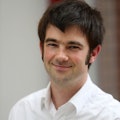
Taking physics to the masses
Our research has helped transform perceptions, teaching practice and public awareness of astronomy.
To your average schoolchild, physics is often thought of as a subject that is boring, difficult, and for boys.
Though highly regarded by employers, and an avenue into a range of amazing careers, students are less inclined to study physics at A-level compared to other science subjects.
Furthermore, just 20 per cent of students taking A-level physics are girls, versus 50 per cent for chemistry and 55 per cent for biology.
This is despite the fact that when girls do study physics, they tend to outperform boys.
“Too many young people, especially girls, are being denied the opportunity to study physics because they are made to feel that it isn’t for them,” says Professor Haley Gomez, from the university’s School of Physics and Astronomy.
“The choices they make can be influenced by a range of factors, prejudices, and stereotypes, which are often perpetuated by the people around them.
“It is so important that we find a way to challenge these stereotypes and break down barriers by showing children what an amazing and fun subject physics can be.”
To combat these issues, Professor Gomez and the outreach team from the School of Physics and Astronomy have been engaged in an extensive programme of outreach activities over the last 10 years, to help demystify the subject and transform people’s perceptions.
From labs to classrooms
Researchers from the university have been involved in some of the most groundbreaking discoveries in astronomy in recent times, from providing unprecedented views of the Universe to studying the physics of the Big Bang.
They have offered new insights into the formation and evolution of stars and galaxies, traced cosmic dust back to the very early Universe, and led the development of crucial equipment that has found its way on to two of the most high-profile telescopes, Herschel and Planck.
It is this breadth of expertise and experience that has underpinned the outreach activities that the team have developed.
“We’re extremely fortunate here at the university to have a number of research groups at the cutting edge of their fields,” Professor Gomez continues.
“This puts them in a wonderful position to relay their experiences to audiences, and to develop activities, interactions, and exhibits that are based on actual data.”
Activities they have helped develop include ‘Chromoscope’, an interactive tool to display the sky as observed at different wavelengths, which includes data taken from the Herschel telescope, and ‘Messier Bingo’, an interactive game designed to locate and view objects captured by the Las Cumbres Observatory network.
Universe in the Classroom
These activities were integrated into the Welsh Government-funded Universe in the Classroom (UitC) project, which targeted schools less likely to engage with science education – specifically those in rural areas, with more students in poverty, and with lower educational attainment.
In 2014 and 2015, the UitC project trained 131 teachers across 99 Welsh primary schools, with 97 per cent of teachers saying they felt more confident when teaching science after the training, and 94 per cent saying they use the University’s resources in their teaching delivery within six weeks of receiving them.
The UitC project also trained 34 undergraduate and postgraduate students to be Stellar Role Models (STARS), a third of whom were female. They went out and delivered 21 workshops within disadvantaged and remote schools across Wales, engaging 871 primary students.
“The aim of Universe in a Classroom was to provide improved teaching methods and innovative tools to modernise and enhance the way STEM subjects are taught to young children,” Professor Gomez explains.
“Presenting children with positive role models is critical to engaging them with the subject. What we discovered during this project was that when students were asked to draw a ‘typical’ scientist, after workshops hosted by female STARS, both male and female students were more likely to draw a female scientist.
“This proved to us that perceptions are driven by experiences, and so getting more female physicists in front of children is a potential game-changer.”
Changing the curriculum
The impact of our outreach activities has gone one step further by fundamentally changing the way physics is taught in classrooms all around the country.
In 2014, the Welsh Joint Education Committee (WJEC), including their subsidiary exam board Eduqas, which is used across Great Britain, consulted the University when revising their AS and A level Physics curriculum.
Encouraged by our wide-ranging and readily available suite of educational resources for multi-wavelength astronomy, the WJEC updated their curriculums to include this topic.
Between 2016 and 2019, there were 11,724 exam candidates across Great Britain who were taught multi-wavelength astronomy within the new AS and A level Physics curriculum, which was supported by a Teacher’s Guide advising teachers to use the university’s resources, such as Chromoscope.
Since 2014, our researchers have also trained over 1,600 teachers and PGCE students with these astronomy resources at over 30 events across the UK.
A happening by chance
The key to engaging children with physics as early as possible is to put them in an environment with fun, challenging, and immersive resources, alongside teachers and role models who are passionate about the subject, according Professor Gomez.
When you have these things in place, the chance of igniting a passion for the subject is much more likely.
“It is surprising where this spark can sometimes come from,” says Professor Gomez. “During my A levels, it was actually a maths teacher who gave me a book about astronomy, and I remember reading all about black holes, and thinking to myself, I have no idea what a black hole is, but it sounds pretty cool.
“So, I read this book all about how scientists have a story behind what they’re doing, and decided it was something I wanted to do myself. It wasn’t long before I completely fell in love with the subject.”
Going on to study an undergraduate physics degree at the university, Professor Gomez never looked back, and is now a world-leading expert on star dust – the building blocks of life – and the processes that determine where, when, and how it forms.
She is passionate about combining her research with her outreach activities, so when an international team, including Professor Gomez, created the first ever 3D image of a supernova remnant – one of the main sources of cosmic dust – it was a natural fit to work with the Smithsonian Institute in the USA to create an online and interactive 3D display of the supernova based on the research.
The Smithsonian Institute reported that the 3D model was showcased to Senators and used across the USA, including in schools and libraries, in STEM outreach programmes for girls, and in exhibits for blind and visually impaired people.
For Professor Gomez, who in 2018 was awarded an MBE for communicating her research to a wide audience, her story is a prime example of how a moment of inspiration can lead to a life-changing decision and the opportunity to inspire others.
“During my undergraduate degree, I was supervised by an amazing professor who I vividly remember saying, ‘we are all stardust’, which really stuck with me and pushed me to want to find out more about the subject,” she explains.
“I thought the idea of a star that has blown up being responsible for us being here on Earth was so poetic. Perhaps if it wasn’t for that one moment in time, I wouldn’t be here today, helping to dispel the myths of physics, and inspiring the next generation of astronomers.”


Outreach at the School of Physics and Astronomy
We inform the public about cutting edge scientific research, provide resources for teachers and inspire young people to develop an interest in science.
Meet the team
Key contacts

Professor Matthew Griffin
Emeritus Professor
Astronomy Instrumentation Group
Cardiff Hub for Astrophysics Research and Technology
Team members

Professor Peter Ade
Emeritus Professor
Astronomy Instrumentation Group
Cardiff Hub for Astrophysics Research and Technology

Professor Peter Hargrave
Head of Astronomy Instrumentation Group
Cardiff Hub for Astrophysics Research and Technology (Co-Director)
Publications
- Ade, P. A. R. et al. 2016. Planck 2015 results. XIII. Cosmological parameters. Astronomy and Astrophysics 594 A13. (10.1051/0004-6361/201525830)
- Gomez, H. L. et al. 2012. A cool dust factory in the crab nebula: A Herschel study of the filaments. The Astrophysical Journal 760 (1) 96. (10.1088/0004-637X/760/1/96)
- Griffin, M. J. et al. 2010. The Herschel-SPIRE instrument and its in-flight performance. Astronomy and Astrophysics 518 L3. (10.1051/0004-6361/201014519)
- Truch, M. D. P. et al., 2009. The Balloon-borne Large Aperture Submillimeter Telescope: BLAST. Presented at: 213th Meeting of the American Astronomical Society Long Beach, USABulletin of the American Astronomical Society
- Holland, W. et al., 2006. SCUBA-2: a 10,000-pixel submillimeter camera for the James Clerk Maxwell Telescope. Presented at: Millimeter and Submillimeter Detectors and Instrumentation for Astronomy III Orlando, FL, USA 24 -31 May 2006. Published in: Zmuidzinas, J. et al., Millimeter and Submillimeter Detectors and Instrumentation for Astronomy III (Proceedings). Proceedings of SPIE--the International Society for Optical Engineering Vol. 6275. Bellingham WA: SPIE. , pp.62751E. (10.1117/12.671186)
Further information
Visit us on Twitter
Find out more about our research at the School of Physics and Astronomy










